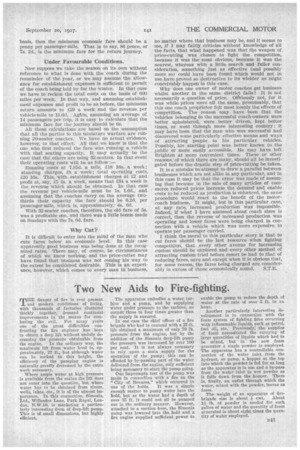Two New Aids to Fire-fighting.
Page 59

If you've noticed an error in this article please click here to report it so we can fix it.
mIIE danger of fire is ever -present.
and modern conditions of living, with thousands of factories clustered thickly together,'demand continualimprovements in the meant for combating the evil. For many years one of the great difficulties confronting the fire engineer has been to obtain a deep lift without unduly deereasieg the pressure obtainable from the engine. In the ordinary way, the maximum lift from water level is, approximately, 27 ft., but although water can be sucked to this height, the efficiency of the pumping engine is naturally greatly decreased by the extra work necessary.
Where ample water at high pressure is available from the mains the lift does not enter into the question, but where water has to be obtained from rivers, wells, lakes, etc., it is of the utmost importance. In this connection, Simonis, Ltd., Willesden Lane, Park Royal, London, N.W.10, is marketing a particularly interesting form of deep-lift pump. This is of small dimensions, but highly efficient. The apparatus embodies a water turbine and a pump, and by supplying water under pressure to the turbine, an output three to four times greater than the supply is ensured.
• In one case the chief officer of a fire brigade who had to contend with a 27-ft. lift obtained a maxim em of only 70 lb. pressure from the engine, but by the addition of the Simonis deep-lift pump the pressure was increased by over 100 per cent. It is not always necessary to rely upon a main supply for the operation of the pump ; this can be effected by by-passing part of the water delivered from the engine, only sufficient being necessary to start the pump going.
One impromptu test of the pump was made in COnneclion with a fire on the "City of Benares," which occurred in one of the holds. It was a simple enough matter to pump water into the hold, but as the water had a depth of over 35 ft it could not all be pumped out in the ordinary manlier. However, attached to a suction hose, the Simonis Pump was lowered into the hold and a fire engine supplied sufficient power to enable the pump to reduce the depth of water at the rate of over 2 ft. in an hour.
Another particularly interesting development is in connection with the foam system of fighting fifes occurring with inflammable' such as petrol, fuel oil, etc. Previously, the supplies of foam necessitated the carrying of large quantities of liquids which had to be mixed, but in the new foam generator a single powder is employed. The apparatus has a controllable connection of the water inlet from the hydrant, or pump, a hopper at the top into which the powder is fed for as long as the apparatus is in use and a by-pass from the water inlet to wet powder as it falls down from the hopper. There is, finally, an outlet through which the water, mixed with the powder, leaves as foam.
The weight of an apparatus of firebrigade size is about f cwt. About 1i lb. of powder is needed for each gallon of water and the quantity of foam generated is about eight times the quantity of water employed.




































































































